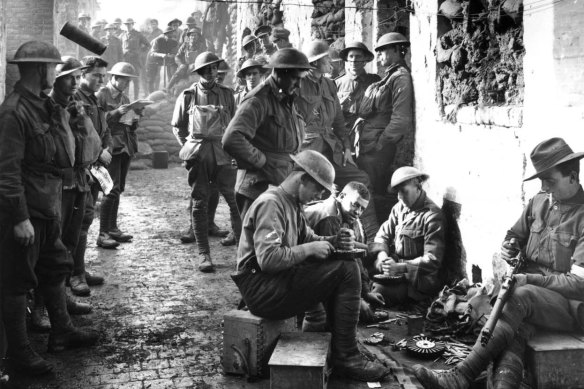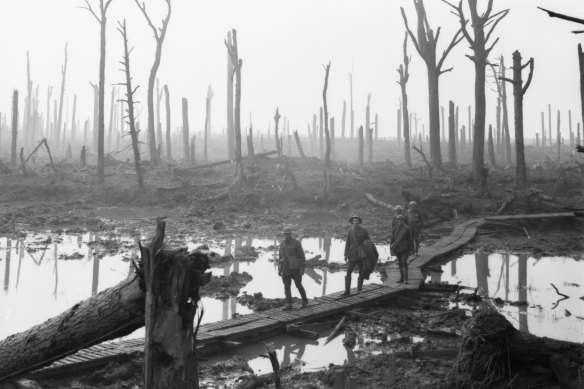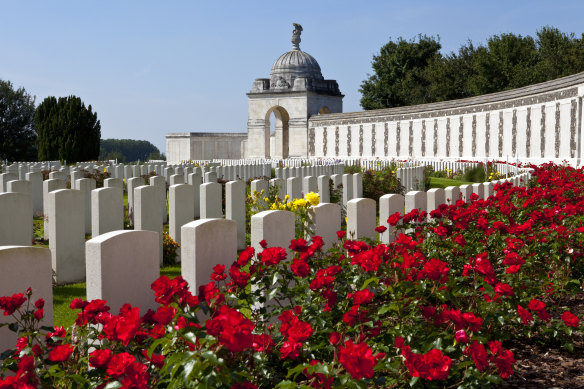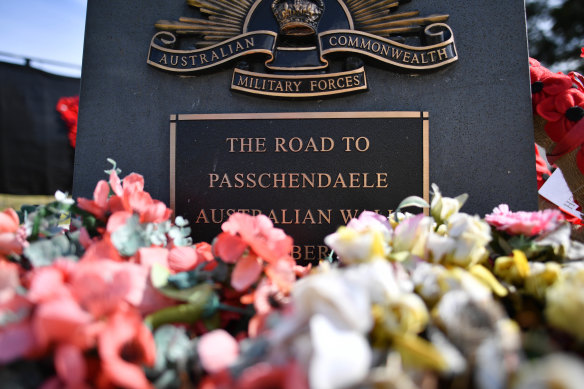
The fragment, he said – without producing it for scrutiny – came from the state library of Dresden, a German city destroyed when set alight by massive British and US bombing raids in February 1945. The truth about those raids – whether they were necessary so late in the war, or whether they amounted to a war crime – is still debated.
Most musical scholars have concluded the Adagio, as ascribed to Albinoni, was a hoax by Giazotto.

Australian troops of First Battalion (NSW) resting at Ypres in November 1917 after the Passchendaele offensive.Credit: Australian War Memorial
Even the origins of that quote about truth being the first casualty are disputed. Some insist it was the Greek dramatist Aeschylus around 550 BC. Others say it was the English man of letters, Samuel Johnson, in 1758. Still others plump for the US senator Hiram Warren Johnson in 1918.
Whatever we accept as truth, and whatever their origins, the adagio and the Cloth Hall are both magnificent, and what happened in and around Ypres during World War I is worse than what we can begin to imagine.
Many of the soldiers who suffered there tried to lighten their mood by gaily mispronouncing Ypres as “Wipers”, and dubbing nearby Ploegsteert – where a memorial now lists 11,000 soldiers who have no known grave – as “Plugstreet”.
But no Australian – or anyone else from the allied forces – ever gave a lighthearted name to Passchendaele, the most hideous battle area of all around Ypres.

Soldiers walk on a duckboard across the shattered landscape during the Battle of Passchendaele in 1917. Credit: Frank Hurley
Passchendaele was merely a village atop a ridge. Allied troops fought a series of increasingly desperate battles from September to November 1917 to reach the village and oust the Germans who held it.
Along the way, the landscape was reduced by shellfire and torrential rain to a quagmire that swallowed men in the mud. Passchendaele cost the Allies 275,000 casualties, 38,000 of them Australians. The Germans lost another quarter of a million men.
And here is the ghastly truth.
It was all for nothing.

Graves at the world’s largest Commonwealth war cemetery at Tyne Cot near Passchendaele.Credit: iStock
Within months, the British forces withdrew from Passchendaele, handing it back to the Germans.
A couple of months ago, my daughter and I were scratching an itinerary for an upcoming holiday in Europe when my daughter pointed to Ypres. “I’d like to go there,” she said.
She wanted to visit the place where my grandfather – her great-grandfather – had been wounded by shellfire. It was at the battle of Polygon Wood on September 26, 1917, on the way to Passchendaele.
Besides, my daughter said, I’d written so much over the years about what happened around Ypres, she wished to place it in a visible landscape.

Flowers at a memorial for Australian soldiers in Belgium.Credit: Joe Armao
I think there was something else on her mind, too.
World War I was supposed to be “the war to end all wars”, but there never was truth to that wild hope.
Daily this century later we are overwhelmed with visions of hell visited upon Palestinians trapped in Gaza, while those behind the air strikes and ground incursions remind us to remember the hell visited first upon Israeli citizens in their own land on October 7.
Loading
The concepts of defence and offence are scrambled, truth having long been a casualty of this conflict.
Ukrainians continue to hold out against Russian invaders sent by Vladimir Putin for reasons that escaped any pretence at truth in the first place.
Since World War II, which at least had the validity of a world standing up to a Nazi force led by a wicked madman and a rapacious Japan, Australians were misled into believing there was worth in fighting for a corrupt regime in South Vietnam, and that Iraq had weapons of mass destruction or could be bombed into democracy.
Our troops fought in Afghanistan for a period spanning 20 years, determined – they and we were told – to keep the Taliban at bay. In a pale re-run of Passchendaele, the Taliban took over the country within days of the withdrawal of Western forces.
And on and on.
My daughter and I will have much to ponder when we visit Ypres and its old battlefields next month.
Start the day with a summary of the day’s most important and interesting stories, analysis and insights. Sign up for our Morning Edition newsletter.



























